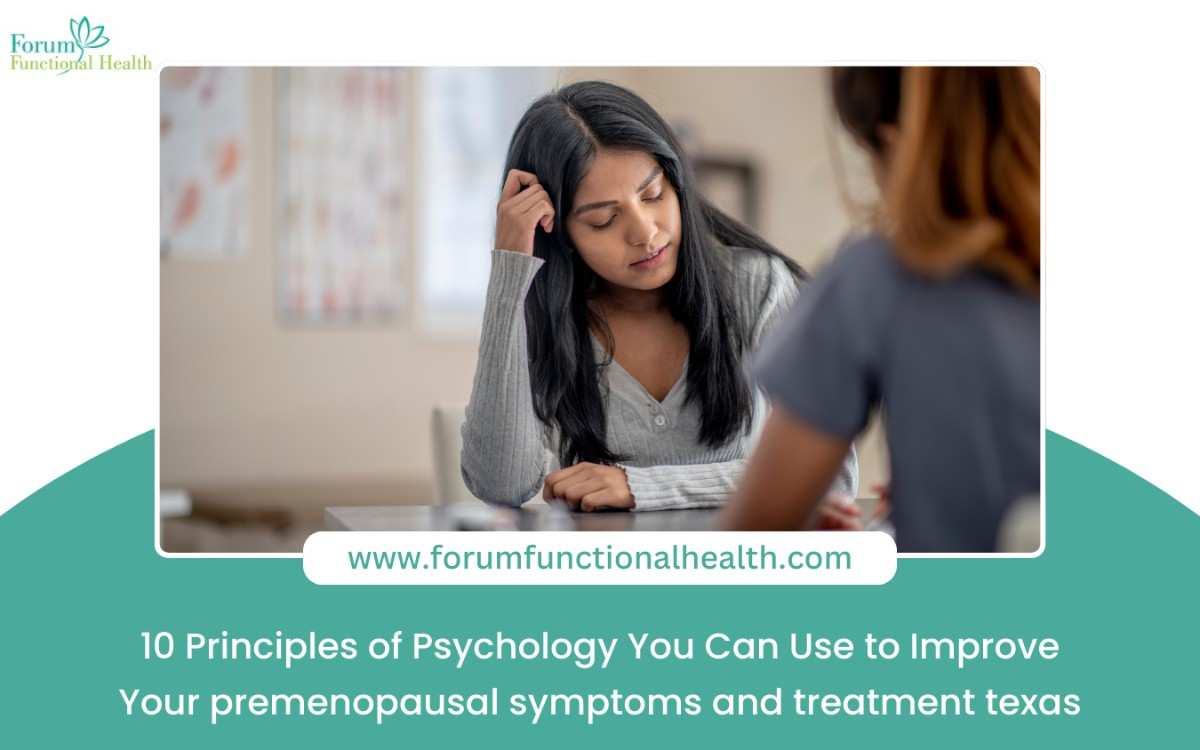10 Principles of Psychology You Can Use to Improve Your premenopausal symptoms and treatment texas

Premenopause, the transitional phase leading up to menopause, is a significant biological and psychological shift for women, typically occurring between the ages of 40 and 50. During this time, fluctuating hormone levels—particularly estrogen and progesterone—trigger a range of symptoms, including:
- Physical symptoms: Hot flashes, night sweats, weight gain, sleep disturbances
- Emotional symptoms: Mood swings, irritability, anxiety, depression
- Cognitive symptoms: Brain fog, memory lapses, difficulty concentrating
While medical treatments (HRT, supplements, lifestyle changes) are commonly prescribed, psychological approaches can significantly enhance symptom management. Research shows that mindset, behavior modification, and stress management techniques can reduce symptom severity and improve quality of life.
In this comprehensive guide, we’ll explore 10 psychology-based principles that can help you navigate premenopause with greater ease, resilience, and control.
1. Cognitive Behavioral Therapy (CBT) for Emotional Regulation
The Science Behind It
CBT is a well-researched psychological intervention that helps individuals identify and reframe negative thought patterns. Studies (e.g., Ayers et al., 2012) have found that CBT significantly reduces anxiety, depression, and irritability in perimenopausal women.
How It Helps with Premenopause
- Reduces catastrophizing (e.g., “I can’t handle these hot flashes”)
- Improves emotional resilience by restructuring irrational beliefs
- Decreases stress-related symptoms like insomnia
Practical Application
- Thought Journaling: Track negative thoughts and replace them with balanced ones.
- Example: Instead of “I’m losing control,” reframe it as “This is temporary, and I can manage it.”
- Guided CBT Apps: Try Woebot or MoodTools for structured exercises.
2. The Placebo Effect: Harnessing Mind-Body Healing
The Science Behind It
The placebo effect demonstrates that belief in a treatment can trigger real physiological changes. Research (Kaptchuk et al., 2010) shows that even if a remedy is inert, expectation can reduce pain and improve well-being.
How It Helps with Premenopause
- Enhances the effectiveness of natural remedies (e.g., black cohosh, flaxseed)
- Reduces perceived severity of symptoms like hot flashes
Practical Application
- Combine treatments with positive affirmations:
- Example: “This herbal tea helps balance my hormones.”
- Visualization techniques: Imagine cooling sensations during hot flashes.
3. Mindfulness Meditation for Stress & Hot Flash Reduction
The Science Behind It
Mindfulness-Based Stress Reduction (MBSR) has been shown to lower cortisol levels, improve sleep, and even reduce hot flash frequency (Carmody et al., 2011).
How It Helps with Premenopause
- Decreases stress-induced hormonal fluctuations
- Improves emotional stability by fostering present-moment awareness
Practical Application
- Daily 10-minute meditation (Use Headspace or Calm)
- Body scan technique to release tension before sleep
4. Social Support & The Buffering Hypothesis
The Science Behind It
The buffering hypothesis (Cohen & Wills, 1985) states that strong social connections reduce the impact of stress on health.
How It Helps with Premenopause
- Reduces feelings of isolation
- Provides emotional validation (“I’m not alone in this”)
Practical Application
- Join menopause support groups (e.g., Menopause Matters Forum)
- Open up to trusted friends about struggles
5. Behavioral Activation to Combat Fatigue & Low Mood
The Science Behind It
Behavioral Activation (BA) is a depression treatment that encourages engagement in rewarding activities to boost dopamine and serotonin.
How It Helps with Premenopause
- Counters lethargy and low motivation
- Improves overall mood
Practical Application
- Schedule small, pleasurable activities (e.g., walking, painting)
- Use a habit tracker to stay consistent
6. Biofeedback Training for Hot Flashes & Night Sweats
The Science Behind It
Biofeedback is a mind-body technique that helps individuals gain control over involuntary bodily functions like heart rate, muscle tension, and skin temperature. Studies (Freedman & Woodward, 1992) found that women who used thermal biofeedback reduced hot flash frequency by 50-60%.
How It Helps with Premenopause
- Trains the body to regulate temperature
- Reduces stress-related sweating
- Improves autonomic nervous system balance
Practical Application
- Use a wearable device (like Muse headband or HeartMath) to monitor stress responses
- Practice paced breathing (6 breaths per minute) to stabilize body heat
- Progressive muscle relaxation to release tension before sleep
7. Positive Psychology: Gratitude & Optimism for Emotional Well-Being
The Science Behind It
Positive psychology (Seligman, 2002) shows that focusing on strengths and gratitude increases serotonin production and counteracts mood swings. A study in Menopause (2018) found that women practicing gratitude had lower anxiety and better sleep.
How It Helps with Premenopause
- Counters negativity bias (focusing only on discomfort)
- Boosts resilience during hormonal fluctuations
Practical Application
- Keep a gratitude journal (write 3 positive things daily)
- Reframe challenges (“My body is adapting, not failing”)
- Use positive affirmations:
- “I am strong and capable of handling change.”
8. Sleep Hygiene & Behavioral Conditioning for Insomnia
The Science Behind It
Poor sleep worsens premenopausal symptoms. Stimulus Control Therapy (Bootzin, 1972) trains the brain to associate bed only with sleep, not anxiety.
How It Helps with Premenopause
- Breaks the cycle of nighttime wakefulness
- Reduces cortisol spikes that disrupt deep sleep
Practical Application
- Strict bedtime routine:
- No screens 1 hour before bed
- Cool, dark room (ideal: 65°F/18°C)
- “Bed = Sleep” Rule: If awake >20 mins, get up and read (no phone)
9. Exposure Therapy for Anxiety Around Symptoms
The Science Behind It
Exposure therapy (used for phobias/PTSD) teaches the brain that symptoms like hot flashes are not threats. A 2020 study found women who practiced acceptance had fewer panic responses to flashes.
How It Helps with Premenopause
- Reduces fear of symptoms (“I’m not dying, just overheating”)
- Prevents avoidance behaviors (e.g., skipping social events)
Practical Application
- Practice symptom tolerance:
- When a hot flash starts, focus on slow breathing instead of fighting it
- Visualization: Imagine the heat as a wave passing through you
10. Self-Compassion: Reducing Emotional Suffering
The Science Behind It
Kristin Neff’s research shows self-compassion lowers stress hormones and increases emotional stability. Menopausal women high in self-compassion report better coping skills (Dunne et al., 2022).
How It Helps with Premenopause
- Softens self-criticism (“I shouldn’t be struggling”)
- Encourages proactive self-care
Practical Application
- Talk to yourself like a friend:
- “This is hard, but I’m doing my best.”
- Mindful self-compassion breaks (Place hand on heart and breathe during stress)
Case Study: Combining Psychology & Medicine
Background: Sarah, 47, had severe hot flashes (10+ daily) and insomnia. HRT helped but didn’t eliminate symptoms.
Psychological Interventions Added:
- CBT to reframe thoughts about aging
- Biofeedback to reduce flash intensity
- Sleep hygiene strict schedule
Result: After 8 weeks, hot flashes decreased to 2-3/day, and sleep improved from 4 to 6.5 hours nightly.
Expert Insight
“The brain’s perception of menopause dramatically impacts symptom severity. Women who view it as a natural transition rather than a ‘failure’ consistently fare better.”
— Dr. Lisa Mosconi, Neuroscientist & Author of The XX Brain
FAQ Section
Q: Can psychology really reduce physical symptoms like hot flashes?
A: Yes. Studies show mind-body techniques (CBT, biofeedback) can cut hot flash frequency by 40-60% by lowering stress hormones that trigger them.
Q: How long until I see results from these methods?
A: Most women notice improvements in 4-6 weeks with consistent practice. Sleep and mood often improve first.
Q: Do I need therapy, or can I do this alone?
A: Many tools (apps, journals) work for self-guided care, but a therapist specializing in women’s health can accelerate progress.
Conclusion: A Mind-Body Approach to Premenopause
Premenopause isn’t just hormonal—it’s psychological, emotional, and behavioral. By combining:
- Cognitive strategies (CBT, reframing)
- Body awareness (biofeedback, mindfulness)
- Lifestyle tweaks (sleep hygiene, social support)
you can rewire your response to symptoms and reclaim stability. Start with 1-2 techniques (e.g., gratitude journal + paced breathing), track changes, and build from there.
